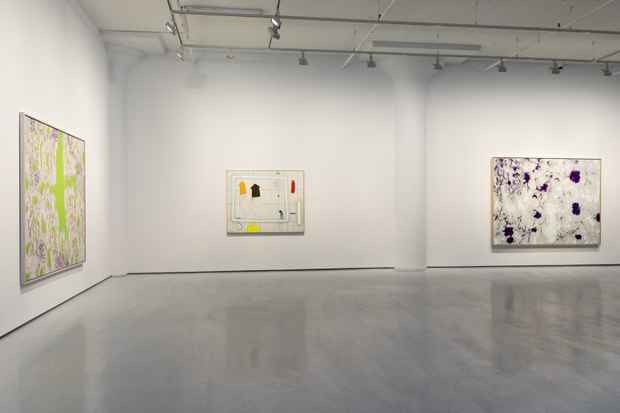Sadamasa Motonaga & Natsuyuki Nakanishi “Counterpoints of the Japanese Avant-Garde”
Fergus McCaffrey (514 W 26th St.)

This event has ended.
Fergus McCaffrey presents Sadamasa Motonaga & Natsuyuki Nakanishi “Counterpoints of the Japanese Avant-Garde” an exhibition pairing two of the most important post-war Japanese
artists to emerge to the attention of the West in the past generation. The exhibition features the
raw and expressive work of Sadamasa Motonaga from the late 1970s, alongside the early 1990s
analytical and philosophical gestural paintings of Natsuyuki Nakanishi—critical periods as these
senior artists continued to map their respective investigation into material, technique,
performance, and culture.
Motonaga (1922–2011) was a largely self-taught artist of the people
and the founding (and only) member of what he deprecatingly
called Aho-Ha or the “Idiot’s School” of Art. Nakanishi (1935–2016)
was Professor of Painting at Tokyo National University of Arts and
Music, and the maker of cerebral abstractions in rather monastic
circumstances. Given their contrasting philosophies and identities,
each artist came to occupy diametrically opposed aesthetic positions
and pushed the development of painting in very different directions;
yet, their divergent practices emerged from the same ashes of World War II as well as their
embrace of unparalleled freedom of artist expression; which came to include painting, sculpture,
performance, and theatre.
Motonaga was an extrovert from the rural hills of Mie Prefecture, the home of the Ninja. In the late
1940s and into the 50s, he made his living variously: as a ballroom dancing instructor, a railway
worker, and a manga artist for regional and national publications. His apotheosis in the Gutai Group
in 1955 took the form of his legendary colored water and plastic tubing installation, Mizu, which
was accompanied by heavily textured paintings of simple shapes like speech bubbles, and stones
and pictograms in primary colors, that drew inspiration from popular culture and children’s art. His
poured painting technique crystalized in 1958, in which the anthropomorphic nature of his work
became almost entirely camouflaged. A year-long residency in New York City in 1966 and the
adoption of airbrush technique began a new chapter in his aesthetic development and the return of
figures, which culminates a decade later in an astonishing group of paintings exhibited at the
gallery. These feature a bold graphic style, freehand airbrush, Schrachitti, and abstract brushwork
all brought together on monochrome flat canvases in a striking reflection of the emerging global
convergence of street art, bad art, and high abstraction in the work of Jean-Michel Basquiat, Keith
Haring, Albert Oehlen, and Martin Kippenberger, among others. In Japan, Motonaga’s style and
erasure of barriers between high and low art would later be codified as Superflat. His work is
resolutely apolitical, optimistic, humorous, and energy giving.
Motonaga has been the subject of many retrospective exhibitions in Japan, most notably at the
Hyogo Prefectural Museum of Art, Kobe, 1998; Hiroshima City Museum of Contemporary Art, 2003;
Nagano Prefectural Shinano Art Museum, 2005; and Mie Prefectural Art Museum, Tsu, 2009. The
first retrospective of the artist’s work in the U.S. was held at the Dallas Museum of Art in 2014,
alongside that of his Gutai colleague Kazuo Shiraga. His works were included in Japanese Art After 1945: Scream against the Sky, Guggenheim Museum, SoHo, 1994; and Tokyo 1955-1970, The Museum of Modern Art, New York, 2013.
Nakanishi grew up in Tokyo where he attended Tokyo National
University of Arts and Music. The textural quality of his early
works, such as Map of Human (1959), which is composed of paint,
enamel, and sand, evoke a sense of the archaic, meanwhile
suggesting contemporary concepts of cell structure and DNA
paths. The materiality of such compositions are in keeping up
with the developments of international art of the period, such as
that of Robert Ryman and Piero Manzoni. Nakanishi’s
1960s Compact Objects—egg-shaped resin sculptures containing mundane objects such as a
sneaker, a broken watch, a mirror, and rusted gears—place a sense of fossilized human detritus at
the center of his work. These objects were an integral part of the Yamanote Line Festival in 1962—
an early precursor to the actions of Hi-Red Center. Nakanishi’s interest in theater and his
involvement in set design and art direction for Butoh dancers, Tatsumi Hijikata and Ushio
Amagatsu, further affected his thinking, pushing him into philosophical and aesthetic subjects
pertaining to painting and performance. This analytical thinking and experimental practice resulted
in a radical reconfiguration of the terms of art-making in a restricted palette of whites, grays,
purples, and greens. In the 1980s, Nakanishi adopted the use of extremely long handled brushes to
increase his distance from the canvases and restrict the fluency of his stroke. The resulting works
have mesmeric compositional dynamics and rhythm that are driven by the artist’s variegated all-
over mark-making, embrace of chance, and intentionally expressive awkwardness.
Solo museum exhibitions of Natsuyuki Nakanishi’s work include: Kitakyushu Municipal Museum of
Art, Japan, 1985; Seibu Museum, Tokyo, 1989; Aichi Prefectural Museum of Art, Nagoya, Japan,
1995, 2002–03; Museum of Contemporary Art Tokyo, 1997; Kawamura Memorial DIC Museum of
Art, Sakura, Japan, 2004, 2012; and The Shoto Museum of Art, Tokyo, 2008. Works by Nakanishi
were also included in Japanese Art After 1945: Scream against the Sky, Guggenheim Museum,
SoHo, 1994; and Tokyo 1955-1970, The Museum of Modern Art, New York, 2013.
Media
Schedule
from April 09, 2021 to May 15, 2021